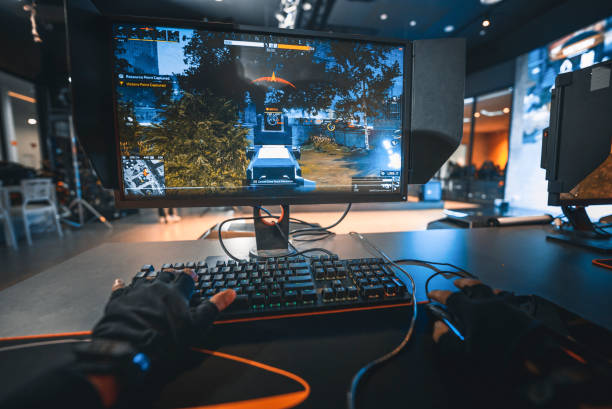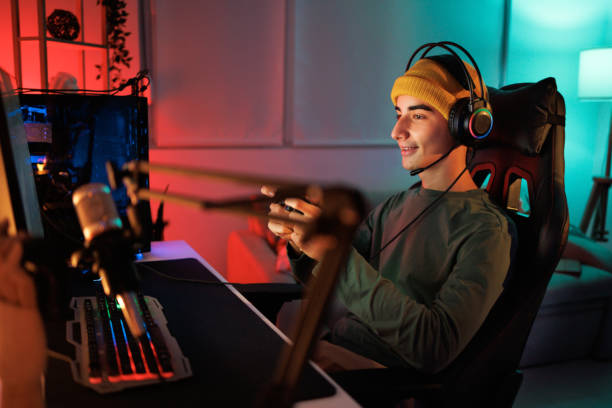
Diverse Esport Team of Pro Gamers Play in Mock-up RPG Strategy Video Game on a Championship. Stylish Neon Cyber Games Arena. Online Broadcasting of Tournament Event. Side View
The metaverse is a rapidly growing virtual landscape of digital experiences. This term was first popularized in Neal Stephenson’s 1992 science fiction novel Snow Crash, but is now being used to describe the ever-expanding boundary of technology and human experiences. From video games to virtual reality, the metaverse encompasses an entire ecosystem of interactive 3-D spaces shared online by millions of users.
In recent years, there has been a tremendous amount of investment and development in this area and it has made significant progress towards becoming a real-world environment populated by humans and machines. In addition, the rapid technological advancement, network infrastructure and hardware has enabled us to digitally explore regions beyond our physical realm.
Today, the metaverse is a vibrant community full of diverse individuals who use it for entertainment, communication and collaboration. In many ways, it can be described as an alternate universe where people from around the globe come together to form friendships, create art and innovate together.
What is the Metaverse?
The “metaverse” is a term used to describe a shared, digital environment analogous to the physical universe — it is often referred to as an “immersive, connected virtual world.” It is a concept that was first imagined in science fiction, but has grown and developed significantly over the years. The metaverse provides users with an alternate reality on which they can interact with other users, create new content, and experience existing content in exciting new ways.
At its core, the metaverse is the total of all online expressions — audio, text, visuals and simulations — which can be interacted with in real-time and interpersonal communication is possible within this virtual environment. This concept of an interconnected metaverse allows unlimited potential for collaboration on projects spanning multiple countries or continents. It also allows for previously impossible levels of creative exploration by allowing users to immerse themselves in diverse environments without leaving the comfort of their homes.
Currently, many platforms allow users to interact in different parts of the metaverse — such as MMOs (massively multiplayer online worlds), AR/VR (augmented reality/virtual reality), video game worlds, interactive streaming services and more. While there are still some significant challenges when building this fully-realized version of the metaverse – namely creating safe and secure spaces while preserving individual privacy – the technology continues to advance exponentially. It represents an incredibly exciting opportunity for those looking to explore virtual worlds.
The Current State of the Metaverse
More and more people are building virtual worlds within the metaverse, and with the help of investments, we have seen a major expansion in this area. Recently, We Raised $93M To Grow The Sandbox Open NFT Metaverse, to help fuel this growth even further.
Let’s explore the current state of the metaverse and how this new investment will affect the future of this space.
The Rise of Non-Fungible Tokens (NFTs)
One of the most notable developments in the metaverse in recent years has been the meteoric rise of non-fungible tokens (NFTs). NFTs are unique digital tokens, stored on a blockchain and secured with cryptography, representing various real or virtual assets. For example, an artist may issue an NFT to certify ownership of a digital artwork and grant buyers exclusive access to that artwork. Through NFTs, consumers can also purchase and manage virtual real estate in virtual worlds or obtain exclusive access to limited edition items such as in-game items or special comic books.
One of the most popular platforms for minting and trading NFTs is OpenSea, which offers a marketplace where users can buy, sell and trade digital assets such as virtual lands, collectibles and game items. Other major players have also started to enter this rapidly growing market, such as EnjinX Motorsports and Nearby Gamma Racing — two upcoming Indie racing games launching on iOS this spring — which will both offer NFTs for players to collect.
The proliferation of NFTs is part of a larger trend towards tokenization across various industries — from digital art and gaming to finance — meaning that the metaverse is redefining how users interact over these platforms and providing new opportunities for developers to create engaging experiences across different virtual worlds. As these platforms become more mainstream in the years ahead, we’re likely to continue seeing an influx of new users interacting with them and more innovative projects coming out of them.
The Growth of the Metaverse
With the prevalence of virtual and augmented reality technologies, we are currently in the midst of a digital renaissance. This technological revolution is playing out within an ever-evolving digital platform, the metaverse.
The metaverse is an amalgamation of existing and emerging technologies that create a new virtual world where users can participate, transact, explore and collaborate in real time. The potential for this technology is virtually limitless — from entertainment to education, gaming to medical research. As the technology evolves, so does the scope of possibilities that open up for its users.
The most popular platforms within the metaverse are applications like Second Life and Sansar, developed by Linden Lab and Oculus Rift. However, these applications only represent a fraction of what’s possible in this rapidly-expanding digital universe. In addition to these two established platforms, there are numerous smaller initiatives taking place that hold immense promise for the future: Oculus Go and Project Baraboo which are focused on mobile VR experiences; Enjin which specializes in virtual goods collectibles; Decentraland with its own tokenized economy; and NeosVR (formerly AltspaceVR) which focuses on social interaction inside its 3D environment.
This only scratches the surface when it comes to what’s feasible within today’s metaverse landscape; we can also expect enormous developments for streaming media (eSports), cryptocurrency investments (NFTs) and blockchain integration (Horizon Platform). These developments will empower more people to enter this exciting space with an expansive range of competencies that add value far beyond traditional boundaries or entertainment experiences.

We Raised $93M To Grow The Sandbox Open NFT Metaverse
The sandbox universe is an open environment powered by programmable assets known as non-fungible tokens (NFTs). NFTs allow users to own and trade digital real estate, collectibles, art, and in-game items. The popularity of non-fungible tokens has exploded over the past year, and the Sandbox project has seen considerable success. A recent $93 million series A round from a venture capital firm consortium shows how committed the firm is to building its open metaverse.
The Sandbox gaming platform allows for ever-evolving virtual worlds, more interactive gameplay experiences, and an even more vibrant economy for users to explore. It is powered by a blockchain layer that governs all interactions on its platform from ownership of game characters (avatars) and virtual lands across multiple universes to ultimately create land auctions in the form of economic activity.
As part of their vision, The Sandbox team has outlined three main objectives they will be focused on:
- Developing a comprehensive set of blockchain tools to power their multiverse.
- Ensure all additional games on their platform respect player data privacy and ownership rights.
- Doing projects with leading content producers (such as museums) within the culture industry.
This latest round will help support these objectives as it helps fuel ongoing development efforts necessary to deliver on this ambitious project’s promises.
Unsurprisingly, there is so much excitement around the Sandbox metaverse given its potential impact on the gaming industry and beyond. However, with this significant investment into The Sandbox ecosystem from top venture capital firms, it appears that The Sandbox’s momentum in becoming one of the most successful non-fungible token projects will only continue going into 2021.

Benefits of the Metaverse
The Metaverse has been gaining traction lately as more and more investors and companies pour money into the space. The recent funding round of $93M to grow the open NFT metaverse is proof of its growing popularity.
This section will explore the various benefits of investing in the Metaverse. We’ll discuss the growth potential of the Metaverse’s ever-evolving technology and the opportunities it presents.
Increased Interconnectivity
The Metaverse, or virtual world, offers increased levels of interconnectivity between people, objects and locations within the digital realm. It provides a platform for users of all ages to connect and create experiences that appear as real as physical experiences. As a result, the Metaverse has become an invaluable tool for businesses, institutions and educational institutions alike.
By leveraging the Metaverse’s digital environment, people can communicate more effectively than ever. Communication across all devices connected to the same network can be seamless. At the same time, virtual reality (VR) headphones allow users to interact with people in distant places and engage in immersive conversations. Furthermore, multiple connections can occur simultaneously as users join conversations and gain access to information shared by others on the network.
Moreover, the Metaverse opens pathways for marketing opportunities; businesses can now approach customers uniquely by providing personalized experiences widely unavailable in traditional advertising campaigns. Through customizable avatars and creative designs entrepreneurs have successfully captured the attention of tenaciously connected consumers who appreciate this tailored approach. Finally, given its ability to support virtual conferences and networking events from anywhere around the world there is a high potential for more efficient collaboration among professionals whose schedules did not allow them to meet previously.
Overall, incorporating technologies such as augmented reality (AR) into the Metaverse enables deliverance of enhanced user experience when compared with physical interaction previously available through tradition communication services and social networks; it is this increased level of convenience that sets it apart from anything before it – bringing about greater interconnectivity for everyone involved which was previously unimaginable!
Increased Accessibility
One of the main benefits of the metaverse is that it makes virtual realities more accessible to everyday users. All individuals can now access rich and immersive virtual environments without complex hardware or software packages. The new concept offers easier access to virtual experiential activities, education, entertainment and information sharing/transformation.
The metaverse increases accessibility in several ways, such as lowering the cost of entry for users, allowing them to use existing hardware instead of requiring additional specialized technology, and simplifying development and maintenance. The metaverse platform also drastically improves usability as it provides an intuitive interface for creating and exploring the experience.
The increased accessibility furthers social inclusion for those who may not have been traditionally distributed in mainstream media including different genders, races or ages. Individuals from a wide range of backgrounds are now able to interact with one another more easily while accessing educational material or cultural events via virtual reality environments. Furthermore, with no physical boundaries imposed on user access within the metaverse, social distance measures such as self-isolation during this pandemic can be managed virtually without significantly impacting education or entertainment needs.
Increased Creativity
The metaverse offers a canvass that is wide open for creativity and innovation. With the latest advances in computer technology, the metaverse provides users with various digital tools such as 3D software applications and virtual reality hardware to aid them in their creative process. Using these tools can result in a wide array of experiences for users, ranging from participating in virtual worlds full of interactive characters and textures, to creating intricate objects or environments that can be shared with a larger user base.
Additionally, the emergence of various open source initiatives has opened up even more opportunities for creativity within the metaverse by providing easy access to a wide range of digital content and allowing users to build off other people’s creations. This encourages an environment where ideas are constantly pushed forward and refined into satisfying experiences.
From these incredibly diverse canvases stem new mediums that can be explored such as video game development, 3D sculpture, animation creation, machinima production and much more; offering exciting avenues to out-of-the-box expression and creative exploration.

Challenges of the Metaverse
The metaverse is a rapidly growing technological concept, and many challenges are involved in its development.
The recent influx of investment has accelerated the idea of an open NFT metaverse. Yet, there are still numerous obstacles in its successful growth and realization.
This article will explore the various difficulties and obstacles that have been encountered so far in the development of the metaverse.
Security and Privacy
A major challenge facing the development of the Metaverse is providing robust security and privacy protections for its users. Developers must ensure user data is secure and confidential as the Metaverse expands, especially when conducting online transactions. Additionally, identity verification becomes more important as user interactions become more complex. Verifying identities within the Metaverse makes it possible to prevent fraud and abuse among users, as well as maintain a degree of anonymity until such time that disclosure is desired or necessary. Fraud prevention also requires developing systems for detecting suspicious behavior and malicious activity on behalf of individuals or groups with malicious intent.
Developers will also need to address privacy concerns, regarding the collection and use of user data within the Metaverse, by implementing measures that protect user information from being shared without their consent or otherwise misused. This includes understanding how user data could be used to create profiles which contain sensitive personal information that companies or governments can use to target individuals in various ways, such as influencing their decisions on products or services they may purchase based on ethnicity or sexual orientation. Additionally, developers must ensure that all personal information collected is used ethically and respects all applicable laws regarding privacy protection.
Scalability
The scalability of the metaverse poses a major challenge for its developers and builders. Users must experience smooth, fast, consistent performance, regardless of location. To ensure this across a vast digital landscape requires robust systems and infrastructure.
For instance, storing user data can be costly in terms of time and money because it must be encrypted and stored securely while still allowing updates in real-time. Additionally, when hundreds of thousands or even millions of avatars enter the metaverse simultaneously from around the globe, networks struggle to provide timely information updates for everyone involved. This can create significant computing demands that result in latency issues, disrupting user experience.
Beyond storage, developers continuously work to make the metaverse an inclusive and accessible platform through open standards that everyone can use without specialized hardware or software requirements. However, adapting an expanding variety of platforms so users enjoy a reliable cross-platform experience remains a significant challenge for today’s builders and developers.
Regulation
While the development of the Metaverse has immense potential, without proper regulation, standards, and compliance, there is an inherent risk of vulnerable manipulations – both technically and socially.
Regulatory frameworks are needed to create safeguard for all users. This will especially benefit sectors utilizing the Metaverse in real estate, finance and e-commerce activities. Those businesses could benefit from a trusted third-party audit to validate trust.
In addition to controlling escalation of virtual realities, regulations need to consider the limits of collecting and using data within or derived from a virtual space. They also have to ensure that users have appropriate control over their data and identities in a secure way that enables analysis of user behavior while preserving privacy.
Moreover, research provides insight into risks beyond technical security within the Metaverse such as maliciousness by either users or providers and possible exploitation on cultural aspects due to disagreements between stakeholders regarding interests or values about certain aspects such as sexism or racial discrimination. The internationalization is also one important regulatory aspect due to an increased complexity because laws will have to be applicable in different jurisdictions making it challenging for developers when it comes to data protection laws across borders. To address these issues internationally accepted certifications can create trust among multiple stakeholders like governments or service providers which could be built upon reasonable ethical frameworks for purposes such as regulation on monetization (including non-cash payments).
Conclusion
Ultimately, the Metaverse represents a new form of digital interaction that promotes global collaboration and creates new opportunities to explore and perhaps even influence virtual and physical environments. Companies like Amazon, Google, Microsoft and Apple are already investing in this space, with many more expected to join shortly. In addition, social media platforms also actively engage with this technology, furthering its potential reach into daily life.
As we move forward into this exciting technological era, it is important for all stakeholders – governments, organizations and individuals alike – to pay close attention to the potential implications of the Metaverse. One of these concerns privacy and data protection; attention here will be key in ensuring user security within these shared virtual spaces. Additionally, governments will need to craft policies that can help guide the structure and implementation of these technologies without limiting their potential applications or inevitable growth. The state of the Metaverse is ever-evolving; staying apprised of its development today ensures that we are prepared for its exciting possibilities tomorrow.






